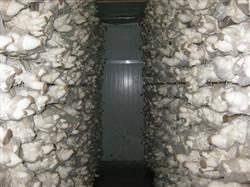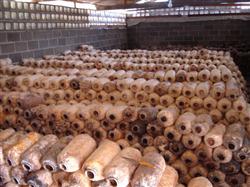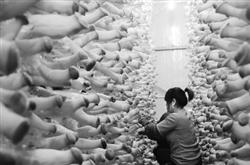Industrial cultivation techniques of Pleurotus eryngii

Pleurotus eryngii, also known as Pleurotus ostreatus, is a kind of high-quality large umbrella bacteria in the mountains, grasslands and deserts of southern Europe, northern Africa and Central Asia. The meat is thick, crisp and tender, and has almond flavor, so it is a high-grade edible fungus. The optimum temperature for the development of Pleurotus eryngii, Pleurotus eryngii and Pleurotus eryngii were 23-25 ℃, 10-18 ℃, 12-15 ℃ and 10-21 ℃. In the industrial cultivation of Pleurotus eryngii in Japan, the processes of mixing, bottling, sterilization, inoculation, cultivation, scratching, mushroom cultivation and bottle digging are all mechanically operated, and the temperature and humidity are automatically controlled by sensors and computers with high investment and high efficiency. Many ideas and technologies are worth using for reference. 1. Mushroom room: divided into fungus room, bud room and mushroom room. The mushroom house is 3.5m wide, 9m long and 3.5m high. The door of each room opens to the corridor (figure 2), which is 2m wide. The wall is sprayed with polyethylene foam thermal insulation. The mushroom rack is arranged in double rows, and there are aisles around and in the middle for easy operation and air circulation. There were 7 layers of mushroom bed with a distance of 0.35 M, 5 layers of budding room and filling room with a distance of 0.45 M, and the distance between the bottom mushroom bed and the ground was 0.25 M. 2. Equipment: there are four main equipment: cooling, ventilation and spray (figure 3) lighting. Each room is equipped with 1 5HP chiller and 1 40M2 ceiling chiller, or 2 rooms with 1 8HP chiller and 2 40M2 ceiling chillers. Two 40W fluorescent lamps are installed on the ceiling of the bud room and the mushroom room and on the longitudinal wall. Each room is equipped with a 45W axial flow electric fan, fresh air is poured into the mushroom through the buffer chamber, and the exhaust gas is discharged from another outlet through the buffer compartment. 3. Sawdust formula (proportion in dry material 100kg): raw material name dry weight contains N% N% remarks miscellaneous sawdust 39kg 1.00 0.39kg dry 85% corncob 39kg 0.48 0.19kg with upper bran skin 20kg 2.20 0.44kg same as calcium carbonate 2kg 00 or lime total 100kg 0 1.02kg N% 1% sawdust first spray accumulation, corncob crushing 0.3-0.5cm particles The water content is 62% and the price is 65%. (domestic formula: cotton husk 68%, bagasse 10%, wheat bran 20%, sucrose 1%, calcium carbonate 1%. The ratio of material to water is 1: 1. 2). 4. Bottling: mechanical bottling, drilling in the center, adding filter cap. Adopt high temperature resistant plastic basket (16 bottles / basket). Bag type: polypropylene bag, wide 17cm, long 36cm, thickness 0.05mm. Load 500 grams of dry material). 5. Sterilization: high pressure sterilization, 121℃, 1.5h. 6. Inoculation: bottle temperature below 30 ℃, inoculation in aseptic room. 7. Culture: constant temperature 23-25 ℃ in the germ room, dark. With the growth of mycelium, the concentration of CO2 in the bottle gradually increased by 0.22% from 0.03% in normal air. Higher concentration of CO2 can stimulate the growth of mycelium, so a small amount of air can be changed during culture. The mycelium can be full after 30-35 days of culture. 8. Scratching bacteria: the mycelium is full and then cultured for 7-10 days to reach physiological maturity. At this time, scratch the bacteria, that is, remove the bottle mouth 1-1.5cm thick aging hyphae. Mechanical operation, including opening the lid, → scratching, → flushing, →, capping, → scratching, can make the mushroom neat. 9. Budding: after scratching the bacteria, go out of the mushroom and turn the bottle mouth down into an empty basket, which is conducive to the recovery of mycelium growth. The air humidity is 90% Mel 95%, the temperature is 12-15 ℃, and the ventilation is moderate. After the mycelium returned to growth, the humidity dropped to 80% Rue 85%, resulting in a humidity difference; the CO2 concentration of 500-800Lx was less than 0.1%, and mushroom buds were formed in 7-10 days. If the concentration of CO2 exceeds 0.1%, the mushroom body is deformed (figure 4) 10, mushroom cultivation: turn the basket after the mushroom bud is formed, make the bottle mouth face up, the temperature is 15-17 ℃, and the humidity is 90% Mel 95%. Adjust the humidity with the sprayer, do not spray water directly to the mushroom body. When the mushroom buds grow to the size of peanuts, use a knife to remove deformities and partially overdense mushroom buds. The yield per bag is positively correlated with the number of mature mushrooms, and the number of mushroom buds per bag should be determined according to market demand. Generally, 4 adult mushrooms per bag have higher yield and quality.) 11. Harvest: the mushroom cover is basically unfolded, harvested when the spores are not ejected, the harvest is large and small, and it is finished in stages. When harvesting a single mushroom, the base of the handle is rotated and pulled out, and the cluster mushroom is cut with a knife. Generally, from budding to mushroom collection for 10-20 days, only one tide is harvested in factory bottle cultivation (figure 5), and the conversion rate is about 50%. After harvest, the bottles are mechanically dug for off-wheel bottling. (generation: 500 grams of dry material per bag, the average yield of the first tide mushroom is about 250 grams) (the conversion rate is 50%); the second tide mushroom can grow again after 10 days, and the maximum yield of the two tide mushrooms per bag can reach 610 grams; the maximum yield of one tide covered with soil can reach 154% (850 amp 550).
- Prev

Operating rules for cultivation of Pleurotus eryngii
Pleurotus eryngii is a kind of large fleshy umbrella fungus growing in the subtropics, with thick meat, fine and strong stalk tissue, white and thick, and excellent taste. It is a kind of edible fungus that sells well in domestic and foreign markets. The cultivation techniques are briefly introduced as follows: first, culture material formula 1, cottonseed hull 80%, wheat bran 18%, gypsum 2%.
- Next

Brief introduction of artificial cultivation and Management techniques of Pleurotus eryngii
Pleurotus eryngii Pleurotuseryngii (DC.exFr) Quel belongs to the genus Pleurotus ostreatus, fungal phylum, basidiomycetes, Basidiomycetes, Pleurotus ostreatus, Pleurotus ostreatus. Pleurotus ostreatus, also known as Pleurotus ostreatus, mainly occurs in dead plants of the umbel family Umbelliferae (root.
Related
- Fuxing push coffee new agricultural production and marketing class: lack of small-scale processing plants
- Jujube rice field leisure farm deep ploughing Yilan for five years to create a space for organic food and play
- Nongyu Farm-A trial of organic papaya for brave women with advanced technology
- Four points for attention in the prevention and control of diseases and insect pests of edible fungi
- How to add nutrient solution to Edible Fungi
- Is there any good way to control edible fungus mites?
- Open Inoculation Technology of Edible Fungi
- Is there any clever way to use fertilizer for edible fungus in winter?
- What agents are used to kill the pathogens of edible fungi in the mushroom shed?
- Rapid drying of Edible Fungi

